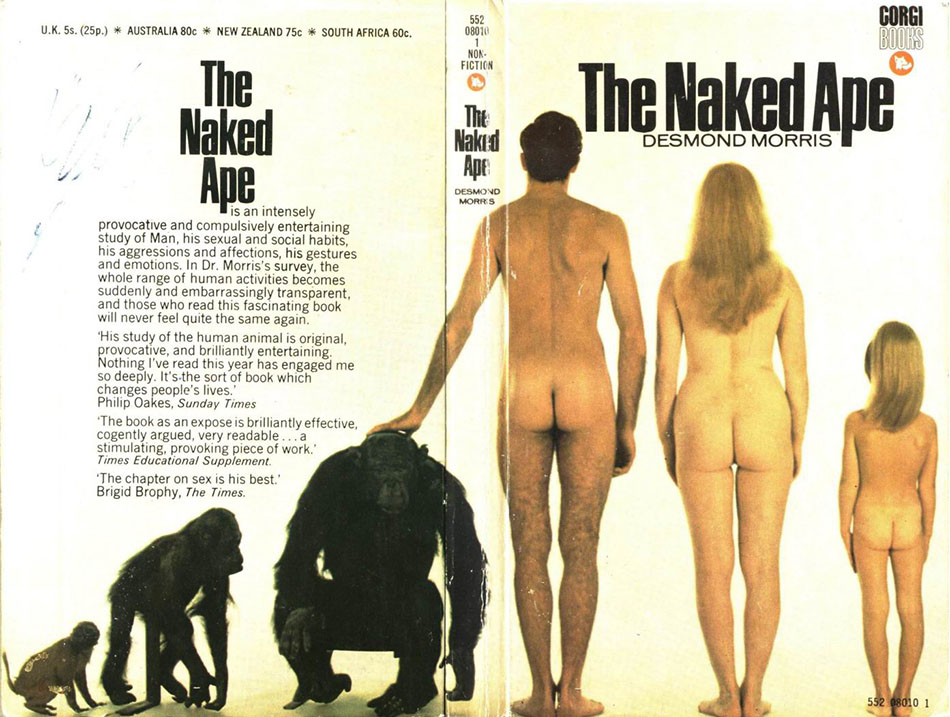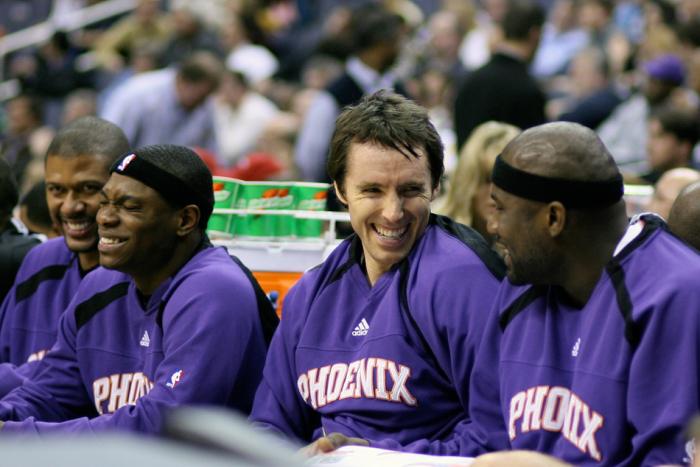There is a passage in Desmond Morris’s The Naked Ape that I think about often. He talks about children playing and describes a pattern that amounts to a set of biological rules. I think about this passage often as I watch my daughter playing, but I also like applying it to my understanding of society and to how I behave as an animal and artist. These rules of play, Morris argues, were shaped by evolutionary processes, and he sets them out in the form of commandments:
1) you shall investigate the unfamiliar until it has become familiar;
2) you shall impose rhythmic repetition on the familiar;
3) you shall vary this repetition in as many ways as possible;
4) you shall select the most satisfying of these variations and develop these at the expense of others;
5) you shall combine and recombine these variations one with another; and
6) you shall do all this for its own sake, as an end in itself.
When my two-year-old daughter plays, she follows these commandments to the letter. She likes to play with balloons these days (play boons, dad?!). She hits a balloon high in the air with her hand, then I hit it, and we try to keep it from touching the ground. If it touches the ground we have to dance and sing odd songs. As the game progresses she tells me to stand in different places, the songs change, sometimes she’ll use a toy tennis racket instead of her hand, but as long as she finds a satisfying pattern of repetition and variation the game will continue for a long time, at the expense of other games and of my sense of freedom.
That passage from The Naked Ape first appealed to me, though, as a neat encapsulation of what it means to be a novelist. When I begin to write something new I investigate the unfamilar until it becomes familiar. Imposing rhythmic repetition on the familiar, varying that repetition, finding the most satisfying variation at the expense of others, and combining and recombining these variations, is exactly what I do when I build sentences, characters and plots, when I try to explore a set of ideas and find the appropriate vocabular music, and when I move from one novel to the next.
In fact it is difficult to find any profession or pastime to which these rules do not apply. I imagine it would be hard to convince a municipal accountant, who commutes for an hour to a flourescent box every day, that as he ratifies budgets and analyzes spreadsheets, he is, in fact, playing; but these inescapable rules affected, at every turn, how he got there and why he stays.
A boy who is good at math is drawn further to learning math. He is encouraged to learn math by adults, and will do so at the expense of learning French or Chemistry or how to do handstands. He learns Functions and Calculus, goes to university, makes like-minded friends, whom he drinks with, plays chess with; and, when he plays ultimate frisbee, every Saturday, he gets tackled by a girl and they fall in love. Their way forward depends on their individual desire for repetition and variation. He wants to keep playing frisbee on Saturdays, she wants to go to museums and travel. She wants kids, he wants to keep things as they are. He gets a job as an accountant at Deloitte, but feels bullied by partners and ambitious colleagues. He is unhappy, stuck, and when he is thirty-five he loses his job and his wife leaves him. A job at City Hall appears, and it appeals to him as a means to be somehow near some centre of power. He lives in the suburbs and his office is a one-hour drive away.
The extent to which he will remain in that flourescent office is uncertain, but every step has been, and will be, dictated by the dynamic described by Desmond Morris’s rules of play.
The Naked Ape was written in 1967, in the chill of the Cold War, and it is interesting to read the book again and realize the almost subliminal presence of nuclear threat. There is a sense that Morris felt a need to evaluate the species in the face of its imminent destruction. We now have more information about apes (including humans) than was available to Morris, but his book remains a fascinating and inevitably relevant read. One interesting fact is not in the book but in the reaction to it. Over ten million copies sold. It was an immensely popular book at the time, and perhaps it was the same nuclear threat, subtly haunting its pages, which motivated people to read it: one of those rare moments when we truly wanted to see who we were.

I think it would be just as difficult to convince our accountant, above, that he is an ape, as it would be to tell him he’s not working, he’s playing. The nuclear threat has, of course, not disappeared, but without two superpowers in constant debate, it is not as much in the public consciousness—at least in most of the English-speaking world. The major issue, both unifying and divisive, which has come to occupy our consciousness, perhaps not exactly in the place of nuclear armament, is global warming, or, broadly speaking, the environment. Whether we are recycling plastic in the kitchen, buying organic food, seeking cars with better fuel consumption, or deliberately doing the opposite of all these things, we are, at some level, thinking of our place on earth and having public discussions about it. Rarely, though, amidst these thoughts, do we pinch our flesh and say what is this. It is remarkable that in the face of nuclear destruction we were more willing to see ourselves as apes than we are now, when we are meant to be thinking of nature.
*
What is play? When chimpanzees play, they look arguably more familiar to humans than in any other posture. An infant chimpanzee being tickled under her armpits looks identical to a human toddler, except for visible body hair and wrinkles. There is laughter, the mouth is open, there is the same sweet discomfort and dynamic of stop, keep going.
Primatologists and people who have raised chimpanzees have all asserted that the only creature that can match a chimp’s appetite for play is a human. When chimps play with each other they run, bite, kick, roll, climb, jump, tickle, laugh, and scream when it all goes wrong. If they are presented with an unfamiliar object (sometimes known as a toy) they fixate upon it—they shake it, smell it, bite it and assess its utility. Some of this behaviour is exhibited among adult chimpanzees, but it is less frequent, less obvious.
As many child psychologists will assert, playing is learning. When chimpanzees play they are discovering what hurts, what they can get away with, what makes others angry. They are testing and refining their physical abilities and learning social limits. This is what human children do.
Playing is rehearsal. There is the obvious physical benefit of learning that if you swing from a high branch, or from monkeybars in a playground, you will hurt yourself if you fall. But the social consequences of play are equally important. When a chimpanzee learns that being obnoxious will alienate certain members of a group, he will use that knowledge later—perhaps in the form of bullying, perhaps in some more subtle negotiation with a rival male or in appeasing powerful females.
A human child will learn how to please or manipulate her parents and siblings from playing at home. Sports teams will teach the more complex politics of finding her place in a larger group, how to give (pass), when to take (score), and what to do when she’s not very good at a sport (write). The human mind, being that of an ape but more complex than a chimpanzee’s, will take the notion and nature of play to different, more elaborate spheres, but the function of play for chimps and humans is the same.
It is rehearsal for survival. It is such an integral part of ape development that finding a dividing line between play and other behaviour feels impossible. There is an obvious point in the lives of adult apes when the laughter weakens or disappears. My daughter laughs uncontrollably when she runs. Few of us laugh on the treadmill. But the habits of play, the rules of play, continue.
A boy who is good at math is drawn further to learning math. He is encouraged to learn math by adults, and will do so at the expense of learning French or Chemistry or how to do handstands. He learns Functions and Calculus, goes to university, makes like-minded friends, whom he drinks with, plays chess with; and, when he plays ultimate frisbee, every Saturday, he gets tackled by a girl and they fall in love. Their way forward depends on their individual desire for repetition and variation.
What we call progress, or sometimes even evolution, is a matter of exercising these patterns of play. Every generation embraces the belief that it has moved on from the past, and this is often an illusion created by our tools. It is easy to look at cavemen as primitive, but harder to realize how helpless we would be if born to a tool-less society. And the development of tools has followed this process of study, refinement, and specialization that by now should look familiar. This refinement follows its own, inescapable logic, and the result is tools that constantly change. The relentless alteration of operating systems for computers and phones is one example.
When I think of my own survival, my mind turns to the publishing industry. Nowhere do The Naked Ape’s rules of play seem more operative than in the behaviour of writers, publishers, and readers. Investigating the unfamiliar, making it familiar, applying rhythm, variation, combining and recombining at the expense of other choices. One of the most common and unifying emotions among writers and publishers is despair; so it may seem, again, inappropriate to stress that we are playing. The usual source of our despair is someone else’s bestseller.
While the success of Fifty Shades of Grey, let’s say, might be baffling to anyone who has either read a good book or had good sex, the behaviour of the industry in the midst of this success is entirely predictable within the rules of play. Whenever there is a publishing phenomenon like this, the industry turns, like a galloping herd, towards the new vista. Six and seven-figure advances are now being handed over to writers of pedestrian erotica, and while the conventional wisdom is simply that ‘it sells,’ the truth is that the books in the line of the leading phenomenon often do not sell, but they make sense to us as apes. For a publisher now to be able to say of the latest, that it is a funnier Fifty Shades, a shadier Fifty Shades, means fulfilling the rules of toying with the familiar. This is the process of modern publishing—whether it is historical fiction, ‘empire strikes back’ fiction from former British colonies, tales of vampires, dragons or wizards; as long as there has been a success, publishers, writers and readers will study it, copy it, alter it, make it part of their very serious play.
And the initial success of all of these phenomena is not so baffling after all: the Harry Potter books, the Dan Browns, and now these Wondrous Greys, are all quite squarely within certain traditions—they have forebears aplenty, and are themselves perfect examples of modified familiarities that initially seem new.
I’d like to be reductive and say that the entire history of literature, English or otherwise, can be described by Morris’s rules of play. When Virgil played with Homer; when Chapman played with Homer; when Shakespeare played with Ovid; all were taking works unfamiliar to their time and place and making them their own. Their art was revealed in rhythmic variations, and in every age the combination and recombination of circumstance and themes has amounted to the fact or illusion that here is something new. The history of literature is of finding new toys, tossing old ones aside, rediscovering the old and making them seem new. It is also a history of competition. Whether or not we are working within a tradition (upholding it or breaking from it), or are competing (consciously or unconsciously) with contemporaries, we writers are part of a timeless contestthat has everything to do with what we are as animals, and nothing to do with culture, time, or place. We are all in a bloodless competition, otherwise known as a game.
The truth about play is that its opposite is not work, it is fighting. Though we may despair while we play, most of us would prefer this to fighting. For chimps and humans, playing is a means of preparing to survive a fight, but it is also, more commonly, a means to avoid one.
When I look at my bank account and realize that, over time, I could have made more money as a babysitter than as a professional novelist, I take comfort in The Naked Ape’s final rule of play. You shall do all this for its own sake, as an end in itself.
I think my daughter understands this. She has various ways of inviting me to play, most of them pretty irresistible, all of them relentless from the moment her eyes are open. She says play games, dad, with either a question or exclamation mark after ‘dad,’ even while we are in the middle of playing a game; she hugs me, pulls me by the hand; my favourite, perversely, is when she stands in front of me, tyrannical, legs apart and one finger raised with terrible authority. Play ... Games ... NOW! Her eyes are wide and she pauses to savour the blood of every word. It is as if she is saying: like it or not, we’re playing.





